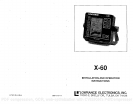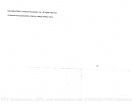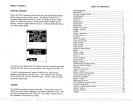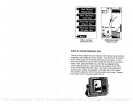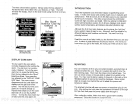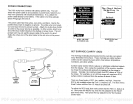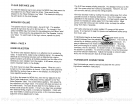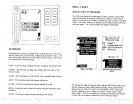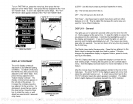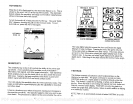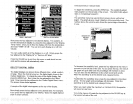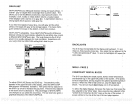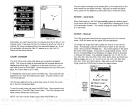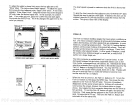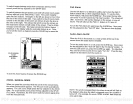
tLEAR
DISTANCE
LOG
To reset the
distance
log
to
zero, press
the MENU
key,
then
press
the
key adjacent
to the
"More" label two
times. Now
press
the
key
adjacent
to the "Clear
Distance
Log"
label. This
resets the distance
log
and
returns to
the chart
display.
SPEAKER
VOLUME
The
speaker
volume has two
steps
-
low and
high.
The
speaker
volume is
high
when the
unit is first turned on.
To
change
it,
first
press
the MENU
key,
then
press
the
key adjacent
to the "More"
label
two times. Now
press
the
key adjacent
to the
"Set
Speaker
Volume
Low" label. To
switch back
to the
high volume,
repeat
the above
steps.
MENU
-
PAGE
4
NOISE
REJECTION
The
X-60's noise
rejection
feature is an
effective tool in
cdmbating
noise. In
sonar
terms, noise is
any
undesired
signal.
It is
caused
by
electrical and
mechanical
sources such as
bilge
pumps, engine
ignition
systems
and
wiring,
air bubbles
passing
over the
face of
the
transducer,
even
vibration from the
engine.
In all
cases,
noise
pro-
duces unwanted
marks
on the
display.
The X-60
has a two
step
nise
rejection system.
Whed the
unit is
turned
on,
the
noiserejection
is
normal. If
you
have
noise
problems
(identified
by
random
lines or dots on
the
display), try
changing
the
noise
rejection
level to
high.
To
do
this,
first
press:the
MENU
key,
then the
key adjacent
to
the
"More" label three
times. Now
press
the
key adjacent
to the 1Set
Noise
Rejection"
label. The
screen below
appears.
Now
press
the
key adjacent
to the
"High"
label. The screen
will clear and return
to
the
chart screen.
The noise
should clear from
the
display
as new
echoes scroll
across the
screen. If
it
isn't,
you may
have a
problem
with
electrical
wiring, engine,
or transducer
installation. Check
with
your
local
dealer, Lowrance service
center,
or the
Lowrance
factory
cu.tomer
service
department
for
help.
The
X-60 has reverse
polarity protection.
No
damage
will
occur to the
unit if the
power
wires are hooked
up
backwards.
However,
the unit
will not work until
you
connect the
wiring
properly.
Minimize electrical
noise
by routing
the
power
cable
away
from other
ppssible
sources of
electrical
interference. One of the
largest
noise
generators
is
the
engine's
wiring
harness. For best
results,
keep
the
power
and transducer
cables
away
from
the
engine wiring.
Bilge
pumps
and their
wiring
can also
radiate
noise,
so
keep
the
cables
away
from
them,
if
possible.
VHF
radio
antennas and cables
radiate RF
energy
at
high
power
levels. It is
important
to
keep
the
power
and transducer
cables
away
from
them,
also.
If qntèrference
begins
at slow boat
speeds
and
gets
worse as the
spead increases,
then the
probable
cause is
cavitation. This noise is
caused
by
air
bubbles
passing
over the
face of the
transducer-. It's
easy
to determine if this
noise is
electrical or cavitation.
Stop
the
boat, put
the
engine
in
neutral,
and
increase the
Rpm.
If the
noise
increases,
then
it's electrical, If it
doesn't show on the
display,
then
the
problem
is
cavitation. To solve this
problem,
move
the transducer
out
pf
the turbulent
water flow.
Adjust
the
bracket so smooth
water
flows over
the transducer's
face at all
boat
speeds.
TRANSDUCER
CONNECTIONS
See the
transducer owner's
manual included with
the unit for
transducer
installation
instructiops.
26
3
PDF compression, OCR, web-optimization with CVISION's PdfCompressor



